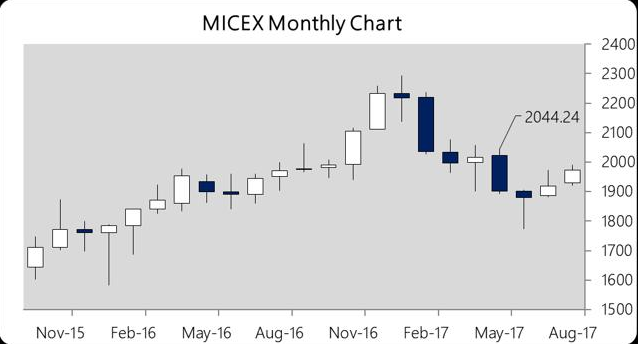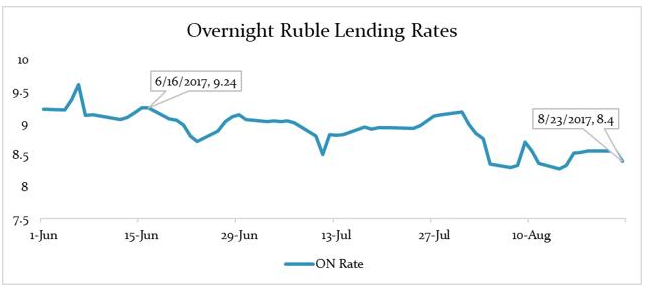Summary- U.S. sanctions hit Russian stocks hard in Q2.
- The MICEX has recovered 11%.
- The Russian banking system is screaming for a rate cut.
Now that we’re a few weeks past the drama of the U.S. sanctions bill I wanted to take a look at the situation in Russian equities to see if there have been any adverse effects. It’s been two months since the bill first made headlines passing through the Senate.
It created a lot of worry that capital would flee the country if the U.S. cut off investors from the market.
But that marked the bottom in the Russian MICEX Index, not the beginning of the end. Since then the Russian stock market has risen 200 points (11.2%) and has resumed its uptrend from a monthly perspective.
This has occurred even though Gazprom (MCX:GAZP, OTC:OGZPY), one of its biggest contributors (15% of weighting) has gotten killed. This should underscore for you just how strong the situation is in Russian equities.
Trade volumes for July were up across the board, year-over-year.

I would be looking for a move above 2044.24, the May high, between now and the end of August as further confirmation that the long-term uptrend in Russian stocks has resumed.
The quarterly chart is still bearish. It would take a September close above the April high of 2058.11 to negate the breakdown on the quarterly chart that occurred in Q1. This is well within the realm of possibility if the MICEX closes above 2000 in August.
Also, it has been two months since the Bank of Russia cut rates to 9.0%. Another rate decision is due soon. Given that inflation is now firmly below the 4% target, wages are rising and the credit markets are healthy, the Central Bank has the room to cut rates further and allow for greater growth of the domestic ruble lending market versus the dollar markets, which are still substantial.
Since the last rate cut the overnight interbank rates have fallen steadily.

On the day of the last rate cut, June 16th, the ruble overnight rate was 9.24%. Bank of Russia President Elvira Nabullina felt things were stable enough to drop rates to 9.0% then. Today, conditions are more favorable. In fact, the market is screaming for a rate cut with the overnight market closing on the Wednesday at 8.4%, having traded below 9.0% for most of August.
Moreover, looking at the weekly bond auction filings for 5-year, 7-year and 15-year government securities, the auctions have all gone off at far lower rates than the Bank of Russia’s benchmark rate.

With the benchmark rate so high, there is still this weird bifurcation between the short-term money markets and the price of government securities. This lack of a coherent pricing of risk needs to be rectified in the coming months.
But, if the Bank of Russia does cut rates this month, which looks very likely, then that should light a fire under the stock market. But, don’t expect the ruble to sell off on the news as lowering rates could actually increase demand for the ruble as lending rises in response.
We saw exactly that with the first rate cut back in March.
With Russian macroeconomic statistics improving every month there is little standing in the way of a rate cut here to further stimulate domestic activity without overheating the economy. In fact, the bigger worry would be large capital inflows through year-end if the interest-rate arbitrage between Russia and Europe/U.S. real rates remain this high, if not higher.
It’s been clear that Russian authorities are worried about hot money flows coming into the country. It is part of why they’ve kept interest rates so high - to discourage unsustainable investment which can be used as a weapon against them at a later date.
For an economy like Russia’s, where most of their exports are demand inelastic primary commodities like oil, gas, metals and grains, there is little incentive to engage in competitive devaluations and therefore it can remain above the fray, importing with a relatively strong ruble from this point forward to fuel domestic economic growth.
The big question marks for Russian stocks remain how strongly Europe follows the U.S.’s demands on sanctions. It seems every day another round of protectionism is announced by the Trump administration. But, since U.S./Russian trade is so minimal, that effect is mostly irrelevant.
The bigger worry for the U.S. is Europe rejecting the sanctions regime and re-opening normal trade. At this point, however, the Van Eck Russia ETF (NYSE:RSX) looks like it has both a strong fundamental bid coming from the MICEX Index as well as the possibility of a bottom in the dollar (PowerShares DB US Dollar Bullish (NYSE:UUP)) in the near future. That will enhance any gains coming out of Moscow and insulate you from any volatility.
I remain bullish on Russia’s recovery and its ability to navigate around, if not wholly ignore, U.S. sanctions and protectionism.
Disclosure: I/we have no positions in any stocks mentioned, and no plans to initiate any positions within the next 72 hours.
I wrote this article myself, and it expresses my own opinions. I am not receiving compensation for it (other than from Seeking Alpha). I have no business relationship with any company whose stock is mentioned in this article.
Editor's Note: This article discusses one or more securities that do not trade on a major U.S. exchange. Please be aware of the risks associated with these stocks.
